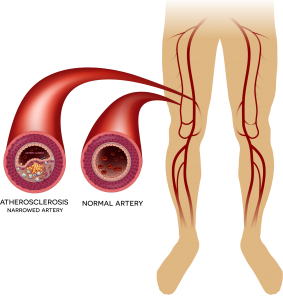Contact Us
For more information about the program or to see if you might qualify, contact the Cardiac Rehabilitation team at 814-467-3029.
Get a Leg Up on Better Health with Supervised Exercise Therapy for Peripheral Arterial Disease
What is Peripheral Arterial Disease (PAD)?
Peripheral Arterial Disease (PAD) is a common circulatory problem where blood flow to the extremities is reduced because of narrowed arteries. A progressive thickening of an artery’s lining is caused by a buildup of plaque (atherosclerosis), which narrows or blocks blood flow. The legs are most commonly affected, but PAD can also affect the arms, stomach, or kidneys. PAD increases your risk for heart attack, stroke, amputation, and death.
 PAD warning signs:
PAD warning signs:
- Aching or cramping in the legs that happens when you walk but goes away with rest
- Foot or toe pain at rest that often disturbs your sleep
- Sores on your feet or toes that are slow to heal
- Leg numbness or weakness
- Coldness in your lower leg or food, especially when compared with the other side
- A change in the color of your legs
A person’s risk of PAD increases with these factors:
- Current or previous tobacco use
- Diabetes
- High blood pressure
- High cholesterol
- Heart disease, heart attack, or stroke
How can CSSMCW help me with PAD?
Supervised Exercise Therapy (SET) for Peripheral Artery Disease (PAD) is now a service covered by most insurances and is offered by the Cardiac Rehabilitation team at CSSMCW. It is an effective intermittent walking program that helps to alleviate the most common symptom of PAD – aching or cramping of the legs that typically occurs when walking and goes away with rest. SET has been shown to be significantly more effective than unsupervised exercise and could prevent the progression of PAD and lower the risk of cardiovascular events that are prevalent in these patients.
Supervised Exercise Therapy (SET)
The program includes:
- Up to 36 sessions over 12 weeks; 3 days/week
- 30-60 minutes of exercise – primary focus is walking
- Education focused on most common risk factors: tobacco use, diabetes & hypertension
The goal of the program is to:
- Reduce symptoms of PAD
- Increase functional capacity
- Reduce risk factors
